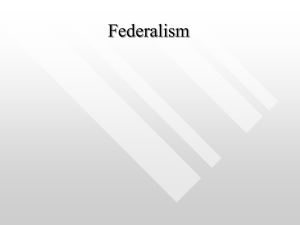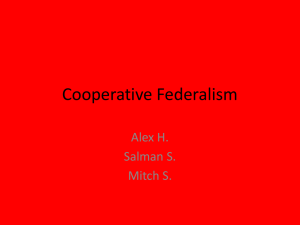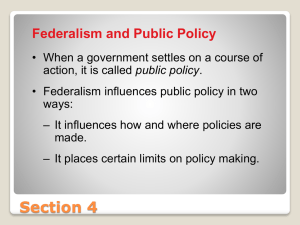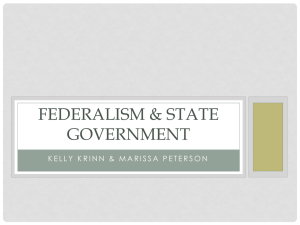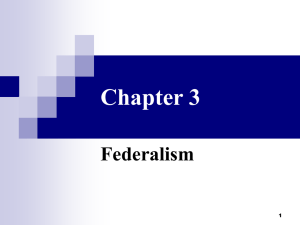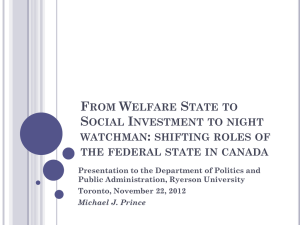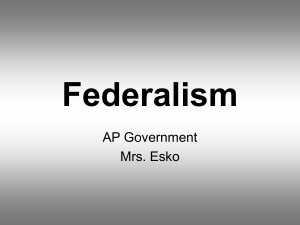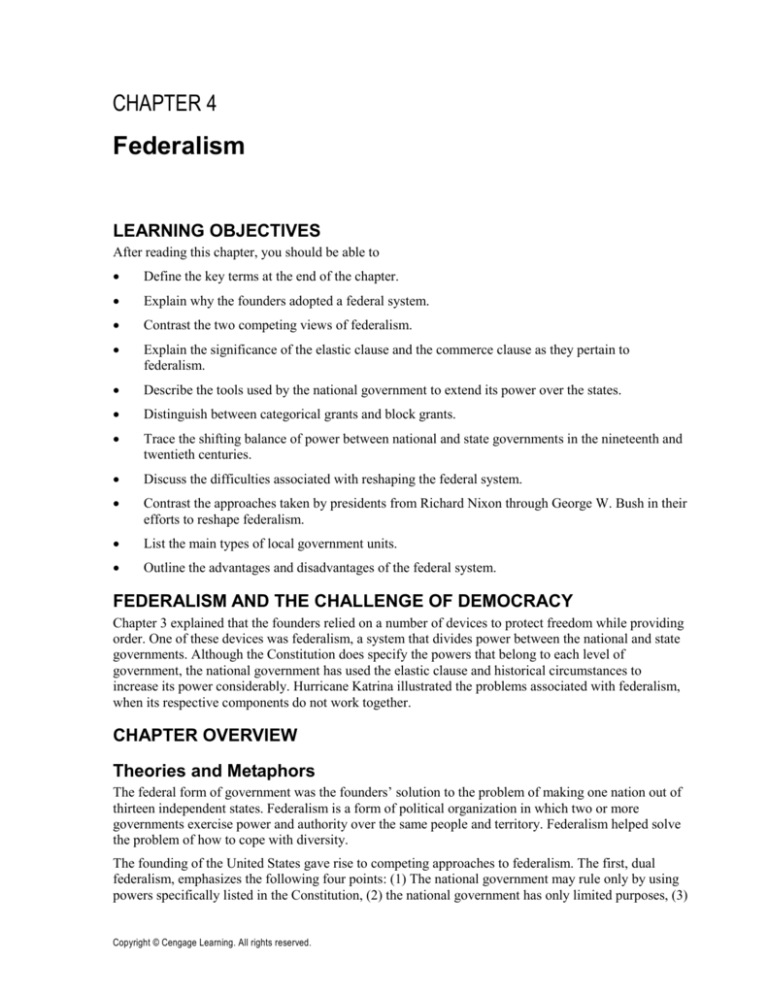
CHAPTER 4
Federalism
LEARNING OBJECTIVES
After reading this chapter, you should be able to
Define the key terms at the end of the chapter.
Explain why the founders adopted a federal system.
Contrast the two competing views of federalism.
Explain the significance of the elastic clause and the commerce clause as they pertain to
federalism.
Describe the tools used by the national government to extend its power over the states.
Distinguish between categorical grants and block grants.
Trace the shifting balance of power between national and state governments in the nineteenth and
twentieth centuries.
Discuss the difficulties associated with reshaping the federal system.
Contrast the approaches taken by presidents from Richard Nixon through George W. Bush in their
efforts to reshape federalism.
List the main types of local government units.
Outline the advantages and disadvantages of the federal system.
FEDERALISM AND THE CHALLENGE OF DEMOCRACY
Chapter 3 explained that the founders relied on a number of devices to protect freedom while providing
order. One of these devices was federalism, a system that divides power between the national and state
governments. Although the Constitution does specify the powers that belong to each level of
government, the national government has used the elastic clause and historical circumstances to
increase its power considerably. Hurricane Katrina illustrated the problems associated with federalism,
when its respective components do not work together.
CHAPTER OVERVIEW
Theories and Metaphors
The federal form of government was the founders’ solution to the problem of making one nation out of
thirteen independent states. Federalism is a form of political organization in which two or more
governments exercise power and authority over the same people and territory. Federalism helped solve
the problem of how to cope with diversity.
The founding of the United States gave rise to competing approaches to federalism. The first, dual
federalism, emphasizes the following four points: (1) The national government may rule only by using
powers specifically listed in the Constitution, (2) the national government has only limited purposes, (3)
Copyright © Cengage Learning. All rights reserved.
34
Chapter 4: Federalism
national and state governments are sovereign in their own spheres, and (4) the relationships between the
state and national governments are marked by tension. This view places importance on states’ rights;
the state and national governments are as distinct and separate as the layers of a cake.
The second approach, cooperative federalism, highlights the following three elements: (1) National and
state agencies perform joint functions, not just separate ones, (2) they routinely share power, and (3)
power in government is fragmented rather than concentrated at one level. The functions of the state and
national governments are intermixed, like the different flavors in a marble cake. Cooperative federalists
stress the Constitution’s elastic clause, which has allowed the national government to stretch its powers.
Cooperative federalism has been associated with liberalism and the tendency to centralize power in the
national government. Conservatives have tended to favor dual federalism, returning power to the states.
Federalism’s Dynamics
Although the Constitution defines the powers of the national and state governments, the actual balance
of power between them has often been a matter of historical circumstances. Constitutional amendments
have led to some change in the balance, but so have legislation and judicial interpretation.
Changes to our federal structure have come about during times of national crisis: the Civil War, World
Wars, the Great Depression, and September 11, 2001. Most of the significant changes occurred during
the Great Depression, when no one but the federal government could offer relief to Americans. The
Great Depression changed how we thought about our government and what it could do for us. Further
changes were made due to 9/11 and the passage of the USA Patriot Act.
One significant change came about through the Voting Rights Act of 1965. With this legislation, the
national government forbade various practices used by the states to disenfranchise African Americans.
Through judicial interpretation, the Supreme Court forced state and local governments to meet demands
they were otherwise unwilling or unable to meet. The Court extended the Bill of Rights to the states,
outlawing segregated schools, providing minimum standards of due process, and forcing the
reapportionment of legislative districts according to the one person, one vote principle. Recently, the
Court has shifted the balance back to the states with the exception of the decision involving the 2000
presidential election.
The balance of power between the national and state governments continues to shift. In the early
nineteenth century, in McCulloch v. Maryland, the Supreme Court backed an interpretation of
federalism that favored a strong national government. The states’ rights issue later stood at the heart of
the dispute between the North and South that led to the Civil War. In the 1930s, the power of the
national government expanded enormously as President Franklin Roosevelt coped with the problems of
the Great Depression. The Supreme Court still held fast to a dual-federalist approach, however, and
struck down many New Deal programs. By the late 1930s, the Court had altered its views about the
balance of power between the national and state governments and sustained acts that expanded the
power of the national government. The general welfare became an accepted concern of the national
government, and thus our government started practicing cooperative federalism in all branches.
The national government also uses financial incentives to extend its power over the states. Grants give
the national government substantial power to induce states to comply with national standards.
Categorical grants, targeted for special purposes, leave recipients with relatively little choice about how
to spend the money; block grants, awarded for more general purposes, allow the recipient more
discretion.
One of the more overlooked areas of federalism is the role of state government. Recently, state
government has grown enormously, and it has professionalized itself as well. More professionalized
jobs, more active legislatures, higher salaries, growing state revenue, and more capable bureaucrats
have all contributed to the rise of state government as a vital component of federalism.
Copyright © Cengage Learning. All rights reserved.
Chapter 4: Federalism
35
Compared with What?
One of the most significant indicators of state government participation in federalism depends on how
active and powerful a state’s governor is. Massachusetts has one of the strongest state governors in the
nation, yet two of the largest states, California and Texas, have some of the weakest. Several factors
contribute to a governor’s effectiveness: budget, veto, appointments, and so on.
Ideology, Policymaking, and American Federalism
Calls to reform the complicated federal system began with Nixon’s New Federalism, which relied
primarily on block grants to shift the balance of power between the nation and the states. President
Jimmy Carter, too, campaigned on a promise to reduce the size and cost of the national government, as
did his immediate successors, Presidents Ronald Reagan and George H. W. Bush. Their efforts to
reshape the federal system relied on program consolidation, budget cuts, and freedom for state officials
in administering programs.
Although the national government now provides states with a smaller fraction of the funds they need, it
still tries to tell state and local governments what to do. Since the mid-1960s, Congress has used
preemption to take over functions that were previously left to the states. Preemption works through
mandates (which force states to undertake activities) and restraints (which forbid states to exercise
certain powers). It results in shifting costs to states for nationally imposed policies. The Republican-led
104th Congress enacted legislation to limit the national government’s ability to pass unfunded mandates
on to the states.
Federalism and the American intergovernmental System
The American system includes more than the one national and fifty state governments. Over eightyseven thousand other governments also exercise power and authority over people living within the
boundaries of the United States. Among them are municipal governments, county governments, school
districts, and special districts.
Theoretically, one advantage of having so many governments is that they allow citizens the opportunity
to decide their own fate in their local community, which they know intimately. However, people are
less likely to participate in local elections than in national ones. A decentralized federal system gives
more points of access to groups representing special interests. The multiplicity of governments also
permits experimentation with new ideas and flexibility in responding to the diversity of conditions that
exist around the country. But some argue that the profusion of governments makes government less
comprehensible to the ordinary citizen.
In reality, the expectations of neither the liberals nor the conservatives have been fully met as
federalism has evolved over the last decade. Greater professionalization in the state governments has
made them more like big governments, ready to take an active role in solving problems. Sometimes this
has meant that states have been willing to set higher standards than the national government for welfare,
product safety, and the like.
Most conservatives would like to return power to the states and reduce the role of the national
government. But as the national government worked to reduce its size and trim the tax burden it
imposes on citizens, state governments grew and raised their taxes. Both liberals and conservatives now
sound the theme of smaller, more efficient government.
Federalism and the International System
Federalism, or more accurately, the interaction of state and local governments, can have a big impact at
the national or local level. One of the best examples is in trade policy. The world is highly globalized,
and many states have no choice but to try and compete in the global market. Most U.S. states now work
Copyright © Cengage Learning. All rights reserved.
36
Chapter 4: Federalism
hand in hand with the U.S. Commerce Department to better sell their products worldwide. As both
entities, states and the federal government, work cooperatively, they are losing their individual
identities, but this seems to be for the better.
Politics of Global Change
Some scholars suggest that the world is moving toward diminished state sovereignty and increased
interstate linkages. The balance between regional autonomy and central government power, the central
problem that federalism addresses, is confronted in contemporary efforts to create a European Union
and in the creation of a new government in Iraq. The creation of the new Iraqi state will test the claim
that the forces of federalism can overcome long-term religious, ethnic, linguistic, and cultural divisions.
Federalism and Pluralism
Although majoritarianism seemed to be the goal, pluralism has taken over much of U.S. government
due to the existence and cultivation of diverse interests. Both forms of federalism support pluralism to
some extent, but in different ways. Blurring the lines of state and federal responsibility promotes
pluralism. At the same time, the federal government is relying more on coercive federalism, which
encourages majoritarianism.
KEY TERMS
sovereignty
federalism
dual federalism
states’ rights
implied powers
cooperative federalism
elastic clause
commerce clause
grant-in-aid
categorical grant
formula grant
project grant
block grant
policy entrepreneur
preemption
mandate
restraint
municipal government
county government
school district
special district
home rule
Copyright © Cengage Learning. All rights reserved.
Chapter 4: Federalism
37
RESEARCH AND RESOURCES
You will find considerable information about U.S. states in one of the most commonly available
reference works, The World Almanac and Book of Facts. Online, the Information Please Almanac at
<http://www.infoplease.com/states.html> offers profiles of each state but is less helpful as a source of
comparative data. Links to the websites of individual states may be found at
<http://dir.yahoo.com/Government/U_S_Government/State_Government>. Project Vote Smart
<http:www.vote-smart.org> also provides information about state government, both current elected
officials and current candidates for the National Council of State Legislatures (NCSL). The NCSL
exists to serve state legislators by providing information, research on critical state issues, publications,
meetings and seminars, a legislative information database, a voice in Washington, D.C., and staff to
assist legislators and their staff in solving problems. The NCSL’s online presence can serve you in your
quest for information about state governments. See <http://www.ncsl.org>.
USING YOUR KNOWLEDGE
1.
Use a copy of the World Almanac and Book of Facts, and look up the word states to get a sense of
the kind of comparative data available on a state-by-state basis, or go to the Government Census
Bureau site <http://quickfacts.census.gov/qfd>. Next, select four states in different parts of the
country, and profile each of them using a common set of characteristics you suspect might have
political importance. (For example, you might look at net migration, ethnicity of population,
indicators that show the importance of industry or agriculture, or military contracts.)
2.
Tour websites of several state governments. Compare the types of information they make
available.
3.
Compare congressional election results for two states in 2004 and 2006. How many seats did each
state have in the House of Representatives in 2004 and in 2006? How many votes did each major
party receive statewide in 2004 and 2006? How many seats did each major party win in each
state? Did one of the major parties benefit from redistricting?
GETTING INVOLVED
One of the great advantages of pluralist democracy is that it provides lots of opportunities for you to get
involved. If you would like to learn more about the inner workings of government, you need not go to
Washington, D.C. With over eighty thousand governments in our system, there are bound to be
possibilities for internships right in your own backyard, in state and local government. It is not possible
to provide detailed information for all fifty states, but here are a few examples of what is out there.
The Citizens’ Forum on Self-Government offers an eight-week program for interns to work on matters
concerned with the structure and function of state and local governments. There is a small stipend. The
application deadline is in mid-April. For further information, write the Intern Coordinator, Citizens’
Forum/National Municipal League, 55 West 44 Street, New York, NY 10036, or call 212-730-7930.
Like their Washington counterpart, several state legislatures have internships available. In Indiana, for
example, the Democratic and Republican Caucuses in each house of the state legislature offer paid
internships to students who help during the legislative session. In addition, the caucuses sometimes help
place internship candidates in positions with interest groups or think tanks in the area. Some other states
offering internships include Florida, Illinois, Michigan, Minnesota, Montana, New York, and Rhode
Island.
Finally, many cities (including Oakland, California; Phoenix, Arizona; New York City; Detroit; and
Los Angeles) offer internship possibilities. Try calling the local government personnel office in your
own area to find out what is available near you.
Copyright © Cengage Learning. All rights reserved.
38
Chapter 4: Federalism
SAMPLE EXAM QUESTIONS
Multiple-Choice Questions
1.
2.
3.
4.
5.
6.
7.
What term best describes the quality of being supreme in power and authority?
a.
eminent domain
b. stare decisis
c.
sentient
d. sovereignty
e.
plurality
What do we call the view that the Constitution is a compact among sovereign states, so that the
powers of the national government and the states are clearly differentiated?
a.
federalism
b. marble cake federalism
c.
confederacy
d. cooperative federalism
e.
dual federalism
Which of the following is not an element of cooperative federalism?
a.
National and state agencies rule jointly.
b. The nation and the states routinely share power.
c.
Power is not concentrated at any one level.
d. Congress and the executive work together to solve problems.
e.
None of the above; all are elements of cooperative federalism.
In early America, majorities feared that people from different regions with different values would
rule them. What was the solution to this problem?
a.
majoritarianism
b. national sovereignty
c.
bicameralism
d. eminent domain
e.
federalism
What does the Tenth Amendment of the U.S. Constitution concern?
a.
states’ rights
b. due process
c.
right to bear arms
d. right to reasonable bail
e.
exclusionary clause
Which of the following is most closely associated with marble cake federalism?
a.
cooperative federalism
b. dual federalism
c.
New Age federalism
d. stratified federalism
e.
territorial federalism
What clause is used as the basis for Congress’s implied powers?
a.
free-exercise clause
b. elastic clause
c.
exclusionary clause
d. supremacy clause
e.
all of the above
Copyright © Cengage Learning. All rights reserved.
Chapter 4: Federalism
8.
9.
10.
11.
12.
13.
14.
39
Block grants can
a.
require state or local governments to match funds.
b. leave little discretion to recipient governments.
c.
leave substantial discretion to state or local governments.
d. rely exclusively on strict formulas to allocate aid.
e.
expand federal control over states.
What element of the U.S. Constitution gives Congress the power to supersede state voting
qualifications and pass the Voting Rights Act of 1965?
a.
First Amendment
b. Tenth Amendment
c.
Fourteenth Amendment
d. Fifteenth Amendment
e.
Nineteenth Amendment
Which Supreme Court case upheld the doctrines of national supremacy and implied powers?
a.
Marbury v. Madison
b. South Carolina v. Katzenbach
c.
McCulloch v. Maryland
d. United States v. Butler
e.
Hammer v. Dagenhart
Which of the following events is most responsible for the end of dual federalism and the
beginning of cooperative federalism and more reliance on the federal government?
a.
American Civil War
b. Spanish American War
c.
World War I
d. Great Depression
e.
Vietnam War
How did the Supreme Court’s decision in Brown v. Board of Education affect the country?
a.
increased the freedom of the states to regulate school attendance
b. radically limited the scope and power of the federal government
c.
promoted equality by outlawing segregation in public schools
d. upheld the role of the states in maintaining the traditional social order
e.
promoted majoritarian democracy by protecting voting rights
Which Supreme Court case concluded that Congress could not require local officials to implement
a regulatory scheme imposed by the national government?
a.
Prinz v. United States
b. United States v. Lopez
c.
Gibbons v. Ogden
d. Bush v. Gore
e.
Atkins v. Virginia
What term is used to describe government money used for a specific purpose or project?
a.
clarified grant
b. block grant
c.
projection grant
d. categorical grant
e.
mandated grant
Copyright © Cengage Learning. All rights reserved.
40
Chapter 4: Federalism
15. Which of the following is not generally advanced as an argument in favor of federalism?
a.
States, acting as laboratories of democracy, may experiment with new policies.
b. People are free to vote with their feet by choosing the state whose laws suit them best.
c.
Federalism acts to promote racial equality.
d. Federalism promotes access for a variety of groups and interests.
e.
Federalism recognizes the diversity of conditions in different states.
16. What term is used to describe government money used for general purposes?
a.
block grants
b. clarified grants
c.
formula grants
d. neighborhood grants
e.
mandated grants
17. Preemption has involved the use of
a.
mandates.
b. restraints.
c.
increased federal power over the states.
d. cost shifting to states.
e.
all of the above.
18. Which of the following is not one of the six categories of gubernatorial power?
a.
budget
b. veto
c.
interpretation
d. appointments
e.
party control
19. What program did Richard Nixon use to decentralize national policy and combine categorical
grants into block grants?
a.
majoritarianism
b. New Federalism
c.
nullification
d. unfunded mandates
e.
pluralism
20. On the basis of a review of White House positions on cases before the Supreme Court, which of
the following is most true?
a.
President Reagan was more likely to support states’ rights than President Clinton.
b. President Clinton was more likely to support states’ rights than President Reagan.
c.
The White House always supports the expansion of federal power.
d. The White House always supports states’ rights.
e.
The White House never stakes out a position on states’ rights.
21. Water is becoming a major problem in the U.S. West. Why?
a.
aging infrastructure
b. overallocation and overuse
c.
continuous land development
d. higher than expected population growth
e.
all of the above
Copyright © Cengage Learning. All rights reserved.
Chapter 4: Federalism
41
22. Which of the following are some of the diverse elements of a country that the French Philosopher
Montesquieu argued lawmakers should consider in formulating the laws of society?
a.
population
b. climate
c.
size
d. ethnicity
e.
economic resources
23. Which of the following would conservatives in Washington be more likely to favor?
a.
expanding the use of categorical grants
b. concentrating power in Washington
c.
returning power to the states
d. expanding the use of unfunded mandates
e.
reducing the authority of state government relative to Washington
24. Congressional district boundaries are typically drawn by the
a.
Supreme Court.
b. Senate.
c.
House of Representatives.
d. state legislatures.
e.
attorney general of the United States.
25. The Supreme Court’s decision in United States v. Lopez suggests a more narrow construction of
which source of national governmental power?
a.
commerce clause
b. unfunded mandates
c.
revenue sharing
d. full faith and credit clause
e.
home rule
Essay Questions
1.
Compare the different aspects of the two competing views of federalism discussed in this chapter.
Justify your position with examples.
2.
Discuss the factors and events that have led to the growth of our national government’s power.
3.
Discuss how government has changed recently and how preemption and mandates have
accelerated under the USA Patriot Act. Use specific examples of gaining and losing power.
4.
Use the case of state building in Iraq to discuss the benefits and disadvantages of locating the
principal powers of government at the regional level or in a central government. What types of
tradeoffs and challenges does the state-building effort in Iraq represent?
5.
How have the various federal grant programs helped or hindered government power at the federal
level?
Copyright © Cengage Learning. All rights reserved.
42
Chapter 4: Federalism
ANSWERS TO MULTIPLE-CHOICE QUESTIONS
1.
d
2.
e
3.
d
4.
e
5.
a
6.
a
7.
b
8.
c
9.
d
10. c
11. d
12. c
13. a
14. d
15. c
16. a
17. e
18. c
19. b
20. b
21. e
22. d
23. c
24. d
25. a
Copyright © Cengage Learning. All rights reserved.



